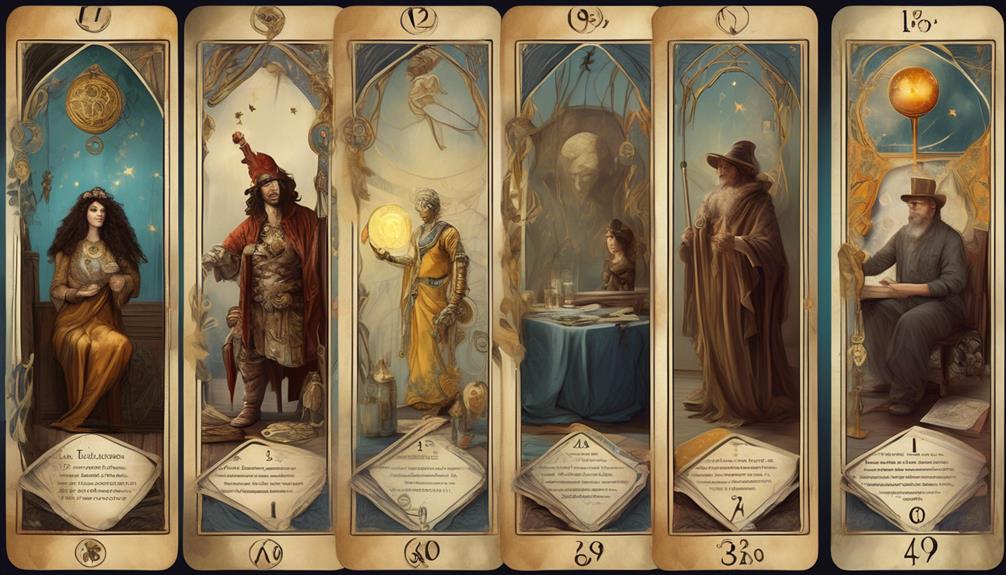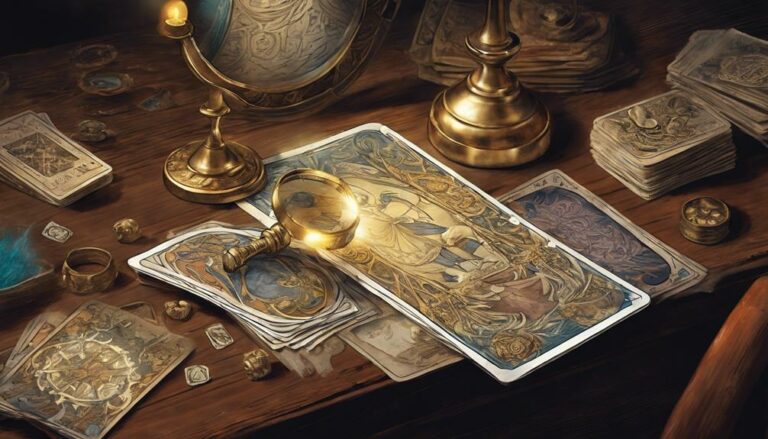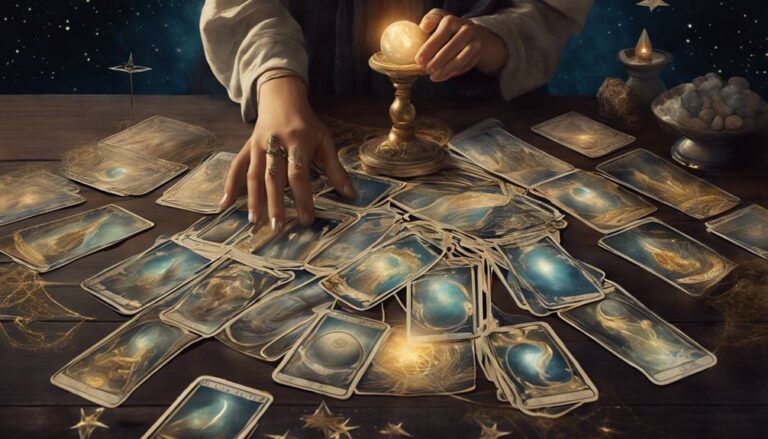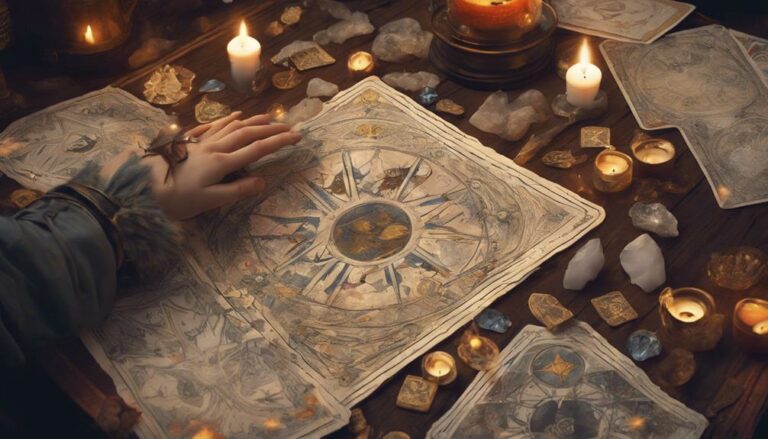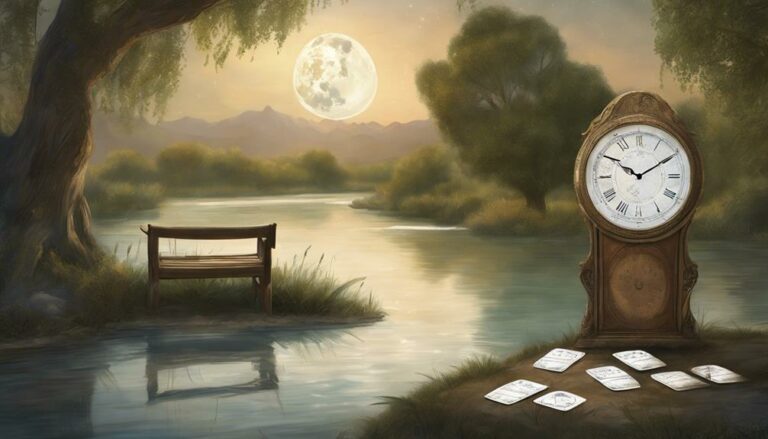It’s fascinating to note that over 78% of tarot enthusiasts regard the Rider-Waite-Smith deck as their go-to for insights and guidance, a testament to its enduring influence since its inception in 1909.
Table of Contents
As someone deeply entrenched in the study and practice of tarot, I’ve observed its remarkable evolution from medieval European card games to a profound tool for divination and self-discovery. This journey has been punctuated by pivotal milestones, such as the shift from playing cards to a form of esoteric wisdom, and the groundbreaking introduction of the Major and Minor Arcana.
Significant figures like Eliphas Levi and A.E. Waite have imbued tarot with rich, symbolic layers that transcend mere fortune telling, integrating it into a broader context of mystical and psychological archetypes.
As we explore these milestones, we uncover not just a history of cards, but a mirror reflecting the complexities of human consciousness and our relentless quest for understanding.
So, why is this exploration crucial for both novices and seasoned practitioners alike?
Key Takeaways
- Tarot cards originated in 15th century Medieval Europe and underwent an artistic transformation during the Renaissance in Italy, highlighting the cultural significance of Renaissance Italy in the development of tarot.
- The structure and symbolism of tarot include the Major Arcana representing spiritual themes and the Minor Arcana focusing on everyday matters, showcasing the adaptability and profound framework for interpreting life’s complexities.
- Tarot cards spread rapidly across Europe since their emergence, becoming a staple in various forms of entertainment and adapting to different cultures by absorbing local symbols and ideologies.
- Tarot’s association with fortune-telling in the 19th century, its enduring appeal, and its connection to ancient wisdom and European mystical traditions demonstrate its role in shaping popular culture and its intertwining with spiritual exploration and divination.
Origins in Medieval Europe
Delving into the heart of Medieval Europe, we find the inception of tarot cards, a fascinating blend of art, culture, and mystery that began its journey in the 15th century, likely within the bounds of Germany. This era marks a pivotal moment in the evolutionary significance of tarot cards, transitioning from mere playing objects to powerful symbols imbued with deeper meanings. The shift from the tarot’s origins in playful gaming to its association with fortune-telling in the 19th century underscores a remarkable cultural influence that reshaped its purpose and perception.
The discovery of luxury decks, such as the Visconti Tarot and the Brambilla Deck, offers a unique window into the historical development and artistic richness of tarot cards. These decks, with their intricate designs and the addition of trump cards, diverged significantly from standard Italian playing cards, incorporating elements like the three theological virtues which weren’t present in other decks. This evolution from simple gameplay to a complex system of divination and reflection on human virtues highlights the tarot’s significant cultural impact, transforming it into a tool for introspection and a mirror reflecting the multifaceted nature of human life.
Transition to Renaissance Italy
As we shift our gaze to Renaissance Italy, it’s clear that this era marked a pivotal moment in the evolution of tarot. Originating in the courts of Italy, tarot cards underwent an artistic transformation, moving beyond mere game pieces to embody deeper, symbolic meanings.
This period also saw the introduction of trump cards, adding a new layer of complexity and insight into the decks that have fascinated us for centuries.
Origin in Italian Courts
Often, the journey of tarot cards begins in the opulent courts of Renaissance Italy, where they transitioned from playful entertainment to mystical tools. This pivotal moment not only marked the birth of tarot as we know it but also underscored the significance of Italian courts in cultivating tarot’s influence on society. Originating as a trick-taking game, the introduction of trump cards added a layer of complexity and symbolism unique to tarot.
| Feature | Significance |
|---|---|
| Trump Cards | Added depth to gameplay, introducing symbolic imagery |
| Visconti-Sforza Tarot | Offers insights into tarot’s historical development |
| Italian Courts | Central to tarot’s evolution and societal influence |
This evolution highlights how tarot’s roots are deeply embedded in the cultural fabric of Renaissance Italy, bridging the gap between history and mysticism.
Tarot’s Artistic Transformation
During the Renaissance in Italy, tarot cards experienced an artistic transformation, evolving into a visually rich and symbolically intricate deck. This period was crucial in tarot’s historical context, marking a significant shift in its cultural significance.
Here’s why this transition was pivotal:
- Luxury Decks: The Visconti Tarot and Visconti-Sforza decks highlighted the artistic craftsmanship influenced by noble patronage, setting a precedent for future designs.
- Trump Cards: The introduction of trump cards with intricate figural representations, like The Courtly Household Cards, added layers of symbolism.
- Cultural Reflection: The decks mirrored Renaissance Italy’s artistic trends, embedding the tarot with deeper cultural and artistic relevance.
This transformation wasn’t just about aesthetics; it laid the groundwork for tarot’s future as a mystic and fortune-telling tool.
Emergence of Major and Minor Arcana

As we explore the evolution of tarot reading, it’s crucial to understand how the Major and Minor Arcana came to be and what they represent.
The Major Arcana’s 22 cards offer a journey through life’s spiritual lessons and universal archetypes, setting the stage for deeper insights.
Meanwhile, the Minor Arcana’s 56 cards, divided into four suits, ground the readings in the everyday experiences and challenges we all face, adding a layer of practical guidance.
Arcana Origins Explored
Exploring the arcana origins unveils how, in the late 15th century, tarot cards transitioned from playful games to profound instruments of divination, marking the birth of the major and minor arcana. This evolution significantly influenced modern divination and deepened tarot’s connection to spirituality.
Here are three key insights:
- The major arcana’s 22 cards encapsulate life’s spiritual lessons, offering a mirror to our soul’s journey.
- The minor arcana reflects daily experiences through its four suits, grounding the spiritual insights in everyday life.
- This duality between the major and minor arcana enriches tarot readings, providing a holistic view that intertwines our mundane and spiritual worlds.
Understanding these origins enriches our appreciation for tarot’s depth, bridging ancient wisdom with contemporary spiritual practices.
Structure and Symbolism
Delving into the structure and symbolism of tarot, we uncover how the emergence of the major and minor arcana offers a profound framework for interpreting life’s complexities and spiritual inquiries.
The evolution of tarot symbolism in modern decks reveals a rich tapestry of human experience, blending historical wisdom with contemporary insights.
Each of the 78 cards, including the four suits and 21 trump cards, carries figural representations that are deeply symbolic.
The major arcana focus on significant life lessons and spiritual themes, while the minor arcana delve into everyday matters and personal experiences.
Cultural influences on tarot card structure have shaped these symbols over centuries, incorporating elements from the mid-15th century Visconti Tarot to the iconic Rider-Waite-Smith deck, showcasing tarot’s adaptability and enduring appeal.
Spread Throughout Europe
The rapid spread of tarot cards across Europe since their emergence in the 15th century underscores a fascinating journey from playful origins to profound cultural significance. Initially surfacing in Italy and possibly Germany, these cards quickly became a staple in various forms of entertainment and later, in more esoteric practices. This spread wasn’t just a matter of geographical expansion; it was a testament to tarot’s adaptability and its ability to resonate across different cultures.
Here are three pivotal moments in this journey:
- The Game’s Beginnings: Tarot’s roots in trick-taking games, popular across Europe, facilitated its widespread acceptance. This laid the groundwork for tarot’s eventual cultural and spiritual significance.
- Cultural Integration: As tarot cards moved from Italy to other parts of Europe, they absorbed local symbols and ideologies, enriching tarot’s symbolism and enhancing its role in popular culture.
- Occult Association: The 19th century marked a turning point with tarot’s association with fortune-telling. This not only expanded tarot’s audience but also deepened tarot’s cultural influences, embedding it firmly in the fabric of European mystical traditions.
Understanding tarot’s journey through Europe illuminates its enduring appeal and its complex role in shaping, and being shaped by, the cultures it touched.
The Marseilles Tarot Design
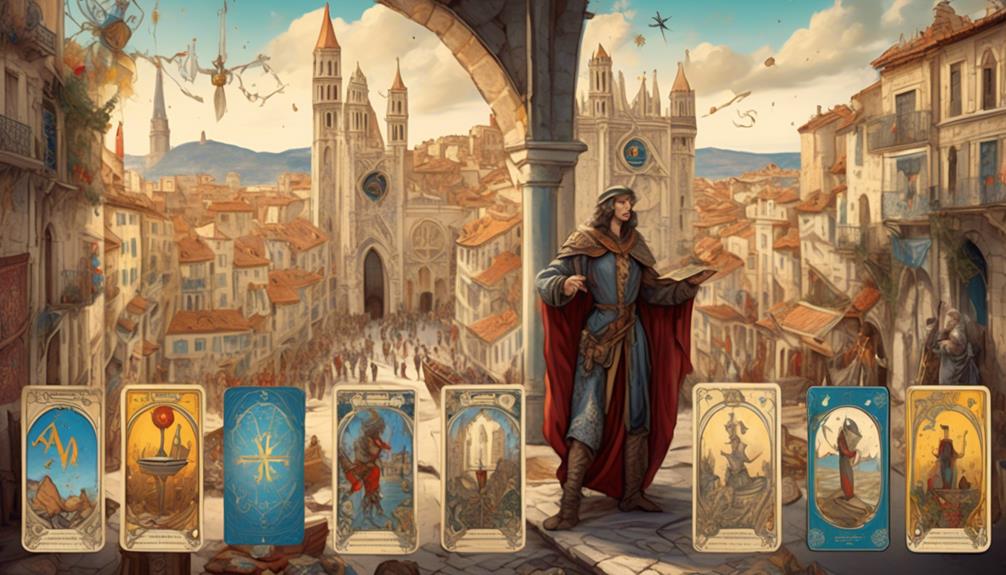
As we turn our attention to the Marseilles Tarot design, it’s clear that its emergence in the 15th century marks a cornerstone in the evolution of tarot reading, showcasing an intricate blend of art and symbolism that has profoundly influenced the standardization of tarot decks.
The Marseilles Tarot, with its classic imagery and symbolism, especially in the trump cards like The Courtly Household Cards, has served as a pivotal foundation for the art of tarot reading. Its historical significance can’t be overstated, providing a window into the soul of past centuries and their spiritual practices.
This design consists of the standard 78 cards, including the four suits of Cups, Swords, Batons, and Coins, alongside the 21 trump cards, each rich in Marseilles Tarot symbolism. This symbolism, woven into the fabric of the cards, offers a language of its own, guiding readers and seekers through the complexities of life’s questions and challenges.
Having stood the test of time, the Marseilles Tarot design not only offers valuable insights into the historical development of tarot cards but also continues to influence the evolution and standardization of tarot decks today. Its impact resonates, bridging past and present in the ever-evolving narrative of tarot reading.
Occult Revival in the 18th Century
Moving from the artistic and symbolic foundations laid by the Marseilles Tarot, we now encounter the 18th century’s occult revival, where tarot’s mystical journey takes a profound leap forward. This era, marked by the contributions of Antoine Court de Gébelin and Jean-Baptiste Alliette (Eteilla), heralded a pivotal shift in tarot’s cultural influence and its connection to ancient wisdom.
Here’s how:
- Court de Gébelin’s Revelation: He made the groundbreaking connection between the tarot trumps and the Hebrew alphabet. This association not only contributed to tarot’s mystical revival but also entrenched its status as a repository of ancient wisdom.
- Eteilla’s Professionalism: Jean-Baptiste Alliette, using the pseudonym Eteilla, became the first professional tarot occultist. His publication of a definitive guide to tarot card reading established the practice as a legitimate tool for spiritual and personal growth.
- Transformation of Perception: The 18th century redefined tarot from a mere game to a powerful medium for divination and self-discovery, setting the stage for its enduring legacy as a symbol of mysticism.
This period was instrumental in shaping the modern perception of tarot, intertwining it with the fabric of spiritual exploration and divination.
A.E. Waite and the Rider-Waite Deck
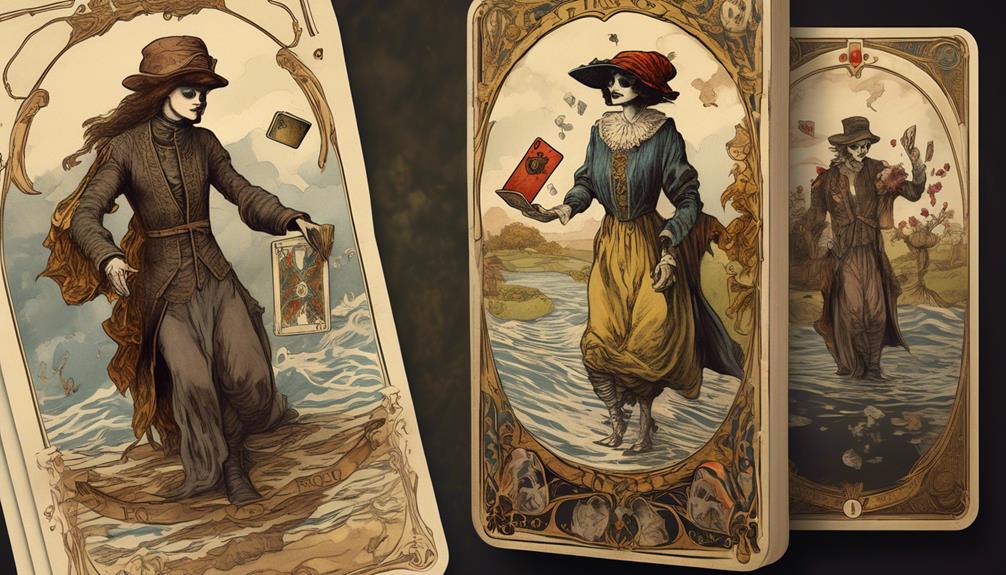
In 1909, A.E. Waite and Pamela Colman Smith revolutionized tarot with the creation of the Rider-Waite Deck. They embedded deep symbolism within both the Major and Minor Arcana, setting a new benchmark for tarot reading. Their collaboration intertwined vivid imagery with spiritual guidance, creating a profound impact on the practice of tarot. The Rider-Waite Deck’s popularity and influence have sustained over time, making it a significant part of contemporary readings. To fully understand its importance, it’s worth exploring its history, artwork, and lasting significance in the tarot community.
Deck Creation History
Delving into the history of deck creation, it’s pivotal to acknowledge how A.E. Waite, alongside Pamela Colman Smith, revolutionized tarot in 1909 with the inception of the Rider-Waite deck. Their collaboration brought forth a deck that not only altered the course of tarot’s evolution but also set a benchmark in deck creation techniques and historical significance.
Here are three key aspects they introduced:
- Detailed Imagery: Unlike previous decks, they included intricate illustrations on all cards, including the Minor Arcana.
- Esoteric Symbolism: Waite infused the deck with rich, occult symbolism, deepening the interpretive layers.
- Influential Interpretations: Their work provided new meanings and interpretations, significantly influencing how tarot readings are conducted today.
Their contributions have undeniably shaped modern tarot, making the Rider-Waite deck a cornerstone in tarot’s rich history.
Symbolism and Artwork
Building on the foundation laid by the revolutionary deck creation techniques of A.E. Waite and Pamela Colman Smith, it’s crucial to explore how their innovative use of symbolism and artwork in the Rider-Waite deck redefined tarot reading.
Their collaboration brought forth a deck in 1909 that was rich in esoteric imagery and intricate symbolism, not just in the Major Arcana but also in the often-overlooked Minor Arcana.
This approach set a new standard, where vivid and detailed illustrations became a conduit for deeper, hidden meanings. The artistic interpretation facilitated by Waite and Smith’s work emphasizes the importance of visual symbolism in enhancing intuitive interpretations.
Their legacy is a testament to how art and intuition intertwine, offering readers a profound tool for accessing the hidden corners of their consciousness.
Impact on Tarot Reading
Understanding the profound impact A.E. Waite and the Rider-Waite Deck have had on tarot reading reveals how they revolutionized the practice with their innovative approach to symbolism and imagery. Their influence on modern tarot can’t be overstated, fundamentally changing how practitioners interpret the cards.
- Comprehensive Imagery: They introduced detailed illustrations in the Minor Arcana, enriching the narrative and depth of readings.
- Iconic Visual Language: The deck’s imagery, like The Fool and The World, became foundational, shaping the visual language of tarot.
- Evolution of Tarot’s Purpose: Waite’s deck pivoted tarot towards self-reflection and spiritual guidance, broadening its impact on divination practices.
These contributions have made the Rider-Waite Deck a cornerstone in the evolution of tarot reading, influencing countless decks and readers since its inception.
Tarot’s Journey to America
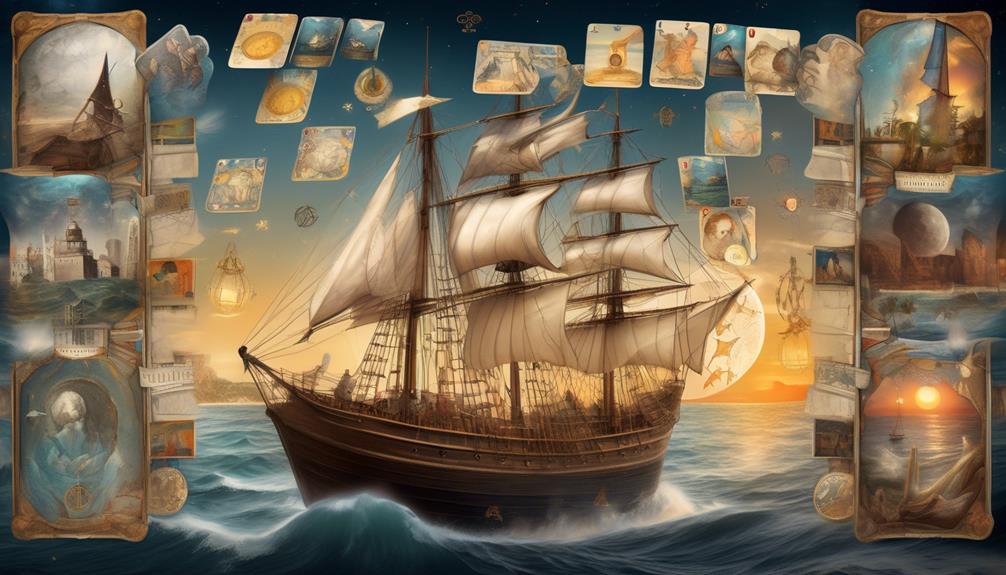
The journey of tarot to America began in the 18th century, brought by European immigrants and gradually weaving its way into the fabric of American spiritual practices. This marked a significant chapter in the evolution of tarot reading in America. As I’ve delved deeper into this fascinating history, I’ve observed how cultural influences have shaped American tarot reading, making it a unique blend of various traditions.
By the 19th century, tarot’s association with divination and the occult had grown, thanks in part to figures like Antoine Court de Gébelin and Jean-Baptiste Alliette. Their influence underscored the mystical allure of tarot, capturing the American imagination. The Rider-Waite-Smith deck, introduced in 1909, further cemented tarot’s place in American spiritual practice. Its imagery and symbolism were pivotal in defining the modern tarot experience, resonating deeply with American seekers.
The Victorian fascination with spiritualism crossed the Atlantic, amplifying tarot’s popularity in America. Throughout the 20th century, tarot reading evolved, integrating into the fabric of American self-reflection and spiritual practices. This journey reflects a rich tapestry of cultural influences, highlighting the dynamic and evolving nature of American tarot reading.
Tarot in the Digital Age
As we’ve traced tarot’s fascinating journey to America and its cultural assimilation, it’s clear that its evolution didn’t stop with physical decks; it’s now embracing the era of digitalization. The leap into the digital age hasn’t only preserved the essence of tarot readings but has also enhanced the experience by making it more accessible and personalized.
Here are three key aspects of tarot’s digital transformation:
- Accessibility and Convenience: Digital platforms have made tarot readings available anytime, anywhere. This ease of access encourages more people to explore tarot’s wisdom for personalized guidance.
- Variety of Spreads and Interpretations: Online tarot platforms cater to a wide range of preferences, offering various spreads and interpretations. This diversity allows users to find readings that resonate with them, creating a more interactive experience.
- Integration of Technology: The digital age has introduced interactive and personalized experiences through the use of modern technology. Virtual decks and applications not only replicate traditional tarot card readings but also offer insights tailored to the individual’s journey.
In essence, the digital evolution of tarot has significantly broadened its reach, allowing more individuals to connect with its ancient wisdom in a modern, interactive, and highly personalized manner.
Modern Interpretations and Uses
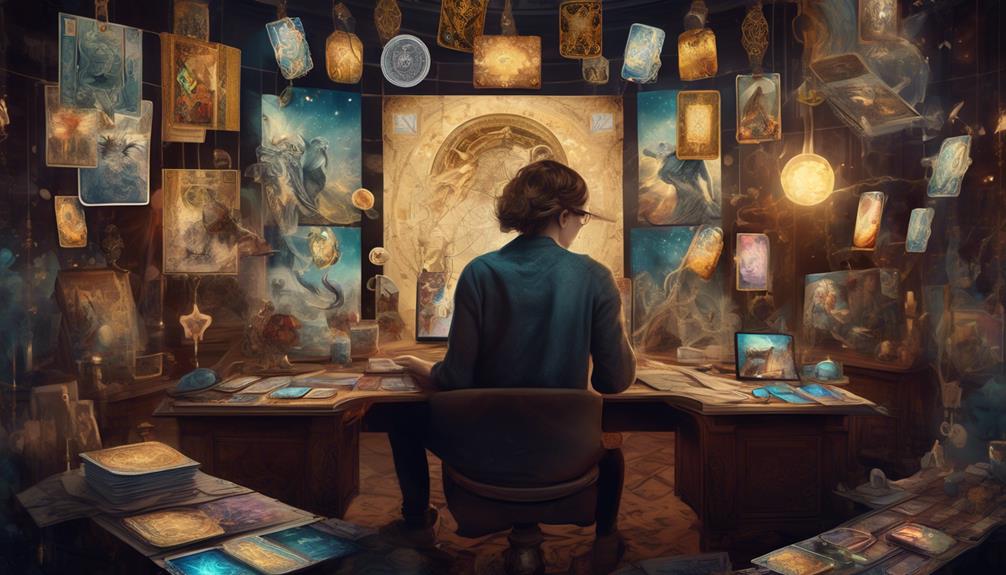
In today’s world, tarot’s evolution extends beyond mere fortune telling, becoming a nuanced tool for psychological insight and personal growth. It’s fascinating to see how modern interpretations of tarot have expanded, encompassing self-reflection, spiritual guidance, and a deeper understanding of personal challenges and opportunities. As someone deeply immersed in this practice, I’ve witnessed firsthand the transformative power of tarot for self-discovery.
Tarot readings have become a cornerstone for many in their journey of self-exploration, acting as a mirror reflecting their subconscious thoughts and emotions. This unique ability to facilitate meditation and cultivate intuition has positioned tarot as a therapeutic tool, invaluable in therapy and counseling sessions. Here, tarot serves as a medium for exploring unconscious patterns, offering clarity on one’s life path.
The evolution of tarot to cater to diverse needs, from relationship guidance to career choices, underscores its versatility and enduring relevance. Whether it’s used as a means of gaining spiritual insight or as a method of personal development, tarot continues to offer profound, multi-dimensional perspectives on our lives, making it more than just a predictive tool—it’s a pathway to understanding our deepest selves.
Frequently Asked Questions
What Is the History of Tarot Reading?
I’ve studied tarot’s rich history, noting its journey from game to divination tool. Artistic influences greatly shaped its evolution, leading to modern adaptations that continue to fascinate. It’s a blend of tradition and innovation.
What Is the Oldest Form of Tarot?
I’ve found that the oldest form of tarot likely emerged in Europe, with card origins pointing to artistic symbolism in the 15th century. This initial phase wasn’t about fortune-telling, but more about social games.
What Religion Is Associated With Tarot Cards?
Sailing through the sea of spiritual diversity, I’ve found tarot isn’t tied to just one religion. Modern misconceptions aside, it’s a mosaic of beliefs, from Christianity to Kabbalah, reflecting its rich, eclectic heritage.
What Culture Are Tarot Cards From?
I’ve learned that tarot cards hail from European culture, heavily influenced by artistic trends of their times. Their evolution into modern adaptations reflects a fascinating blend of history and contemporary creativity, shaping tarot’s unique identity.
Conclusion
In my years of navigating the tarot’s evolution, I’ve found an amusing irony in its journey. We’ve taken a medieval pastime, once a mere card game, and transformed it into a profound tool for introspection and divination.
It’s amusingly ironic how we seek ancient wisdom in what was essentially medieval entertainment. The Rider-Waite deck, now a cornerstone of modern tarot, was once a radical innovation.
As we embrace tarot in the digital age, I can’t help but chuckle at the thought of medieval players witnessing their game’s transformation into an emblem of mystical insight. Yet, here we are, turning pixels into portals of understanding.
The tarot’s evolution is a testament to humanity’s eternal quest for meaning, wrapped in the delightful irony of finding profound truths in the humblest of origins.

